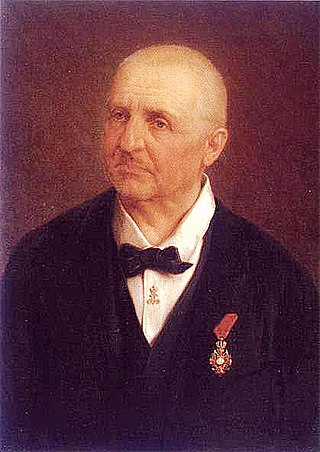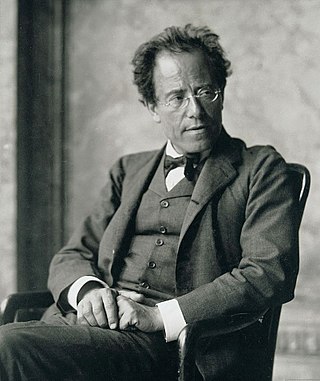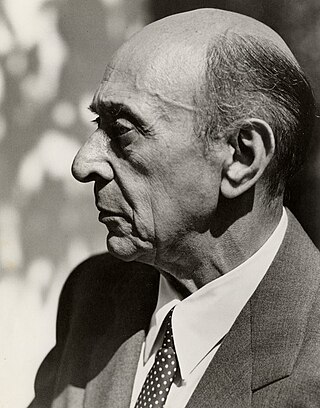
Josef Anton Bruckner was an Austrian composer and organist best known for his symphonies and sacred music, which includes Masses, Te Deum and motets. The symphonies are considered emblematic of the final stage of Austro-German Romanticism because of their rich harmonic language, strongly polyphonic character, and considerable length. Bruckner's compositions helped to define contemporary musical radicalism, owing to their dissonances, unprepared modulations, and roving harmonies.

Gustav Mahler was an Austro-Bohemian Romantic composer, and one of the leading conductors of his generation. As a composer he acted as a bridge between the 19th-century Austro-German tradition and the modernism of the early 20th century. While in his lifetime his status as a conductor was established beyond question, his own music gained wide popularity only after periods of relative neglect, which included a ban on its performance in much of Europe during the Nazi era. After 1945 his compositions were rediscovered by a new generation of listeners; Mahler then became one of the most frequently performed and recorded of all composers, a position he has sustained into the 21st century.

Arnold Schoenberg or Schönberg was an Austrian-American composer, music theorist, teacher, writer, and painter. He is widely considered one of the most influential composers of the 20th century. He was associated with the expressionist movement in German poetry and art, and leader of the Second Viennese School. As a Jewish composer, Schoenberg was targeted by the Nazi Party, which labeled his works as degenerate music and forbade them from being published. He emigrated to the United States in 1933, becoming an American citizen in 1941.

The Symphony No. 7 by Gustav Mahler was written in 1904–05, with repeated revisions to the scoring. It is sometimes referred to by the title Song of the Night, which Mahler never knew. Although the symphony is often described as being in the key of E minor, its tonal scheme is more complicated. The symphony's first movement moves from B minor (introduction) to E minor, and the work ends with a rondo finale in C major. Thus, as Dika Newlin has pointed out, "in this symphony Mahler returns to the ideal of 'progressive tonality' which he had abandoned in the Sixth". The complexity of the work's tonal scheme was analysed in terms of "interlocking structures" by Graham George.
Erwin Ratz was an Austrian musicologist and music theorist. He is known especially for his work as president of the Gustav Mahler Gesellschaft and for his book Einführung in die musikalische Formenlehre. During Nazi rule, he saved the lives of several Austrian Jews by sheltering them in his apartment for a number of years.
Deryck Cooke was a British musician, musicologist, broadcaster and Gustav Mahler expert.
The curse of the ninth is a superstition connected with the history of classical music. It is the belief that a ninth symphony is destined to be a composer's last and that the composer will be fated to die while or after writing it, or before completing a tenth.
Arnold Schoenberg's Piano Concerto, Op. 42 (1942) is one of his later works, written during his exile in the United States. It consists of four interconnected movements: Andante, Molto allegro, Adagio, and Giocoso. Around 20 minutes long, its first performance was given on February 6, 1944, at NBC Orchestra's Radio City Habitat in New York City by Leopold Stokowski and the NBC Symphony Orchestra with Eduard Steuermann at the piano. The first UK performance was on 7 September 1945 at the BBC Proms with Kyla Greenbaum (piano) conducted by Basil Cameron. The first German performance took place at the Darmstadt Summer School on 17 July 1948 with Peter Stadlen as the soloist.

Leon Kirchner was an American composer of contemporary classical music. He was a member of the American Academy of Arts and Letters and the American Academy of Arts and Sciences, and he won a Pulitzer Prize for his String Quartet No. 3.

Simone Margaret Young AM is an Australian conductor. She is currently chief conductor of the Sydney Symphony Orchestra.

Hans Rosbaud was an Austrian conductor, particularly associated with the music of the twentieth century.

Gurre-Lieder is a tripartite oratorio followed by a melodramatic epilogue for five vocal soloists, narrator, three choruses, and grand orchestra. The work, which is based on an early song cycle for soprano, tenor and piano, was composed by the then-Austrian composer Arnold Schoenberg from 1900 to 1903. Following a break, he resumed orchestration in 1910 and completed it in November of 1911. It sets to music the poem cycle Gurresange by the Danish novelist Jens Peter Jacobsen.

A Survivor from Warsaw, Op. 46, is a cantata by the Los Angeles–based Austrian composer Arnold Schoenberg, written in tribute to Holocaust victims. The main narration is unsung; "never should there be a pitch" to its solo vocal line, wrote the composer.
Progressive tonality is the music compositional practice whereby a piece of music does not finish in the key in which it began, but instead 'progresses' to an ending in a different key or tonality. In this connection 'different key' means a different tonic, rather than merely a change to a different mode : Gustav Mahler's Second Symphony (1888–94), for example, which moves from a C minor start to an E-flat major conclusion, exhibits 'progressive tonality'—whereas Ludwig van Beethoven's Fifth Symphony (1804–08), which begins in C minor and ends in C major, does not. A work which ends in the key in which it began may be described as exhibiting 'concentric tonality'. The terms 'progressive' and 'concentric' were both introduced into musicology by Dika Newlin in her book Bruckner, Mahler, Schoenberg (1947).
Harold Byrns was a German-American conductor and orchestrator.
Dika: Murder City is a 1995 documentary film by Michael D. Moore on the late-life punk rock career of composer/singer Dika Newlin. The film features Newlin, who was 74 years old when the film was shot, in concert at a Richmond, Virginia, club where she is wearing black leather garb and singing punk versions of Elvis Presley and Nancy Sinatra songs. Newlin also talks about her childhood musical training with Arnold Schoenberg, and she performs several of her original songs. She also offers a Gioachino Rossini aria, Duetto Buffo di Due Gatti in which she meows the entire number. A clip from the 1968 film Night of the Living Dead is included in the film.

Alexander Zemlinsky or Alexander von Zemlinsky was an Austrian composer, conductor, and teacher.

Style and Idea: Selected Writings of Arnold Schoenberg is the name for a published collection of essays, articles and sketches by Arnold Schoenberg, that has appeared in various forms.

The Begleitungsmusik zu einer Lichtspielscene, Op. 34 —also known in English as Accompaniment to a Film Scene, Accompaniment to a Cinematographic Scene, Accompaniment to a Cinematic Scene, and Music to Accompany a Cinema Scene—is an orchestral work by Arnold Schoenberg composed in late 1929 and early 1930.











